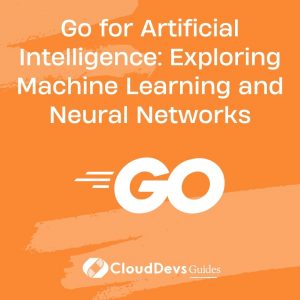Go for Artificial Intelligence: Exploring Machine Learning and Neural Networks
Artificial Intelligence (AI) has become an integral part of our lives, from voice assistants to recommendation systems and self-driving cars. Behind the scenes, these AI marvels are often powered by machine learning and neural networks. While languages like Python have traditionally dominated the AI landscape, Go, a statically typed language known for its simplicity and efficiency, is emerging as a powerful contender. In this article, we’ll delve into the world of AI, machine learning, neural networks, and how Go programming is making its mark in this exciting field.
1. Understanding Artificial Intelligence and Machine Learning
1.1. The Rise of Artificial Intelligence
Artificial Intelligence is the simulation of human intelligence processes by machines, primarily computer systems. It enables machines to perform tasks that typically require human intelligence, such as problem-solving, understanding natural language, recognizing patterns, and making decisions. AI can be categorized into narrow AI, which is designed for a specific task, and general AI, which exhibits human-like intelligence across a wide range of tasks.
1.2. The Essence of Machine Learning
Machine Learning is a subset of AI that involves the development of algorithms allowing computers to learn from and make predictions or decisions based on data. Unlike traditional programming, where rules are explicitly defined, machine learning models improve their performance over time through exposure to data. This data-driven approach enables machines to adapt and generalize their knowledge.
2. Neural Networks: The Backbone of Machine Learning
2.1. Unleashing Neural Networks
At the heart of many machine learning breakthroughs lies neural networks. These are computational models inspired by the structure and function of the human brain. Neural networks consist of interconnected nodes, also known as neurons, that work together to process and analyze data. Deep Learning, a subset of machine learning, uses deep neural networks with multiple layers to extract complex patterns from data.
2.2. The Role of Activation Functions
Activation functions are a crucial component of neural networks. They determine the output of a neuron based on its input. Common activation functions include the sigmoid function, hyperbolic tangent (tanh) function, and Rectified Linear Unit (ReLU) function. Activation functions introduce non-linearity to the network, enabling it to capture intricate relationships within the data.
go
// Example of a ReLU activation function in Go
func ReLU(x float64) float64 {
if x > 0 {
return x
}
return 0
}
3. Go: A Rising Star in AI
3.1. Go’s Appeal in AI Development
While languages like Python have dominated the AI landscape, Go is gaining traction due to its unique features. Go’s simplicity, performance, and excellent concurrency support make it well-suited for AI tasks that require efficient data processing. The compiled nature of Go code results in faster execution, a crucial factor for large-scale AI applications.
3.2. Gorgonia: Building Neural Networks with Go
Gorgonia is a popular library in the Go ecosystem that facilitates the creation and training of neural networks. It provides essential tools for defining computational graphs, performing automatic differentiation, and optimizing machine learning models. Let’s take a look at a simple neural network built with Gorgonia:
go
package main
import (
"fmt"
"log"
"gorgonia.org/gorgonia"
"gorgonia.org/tensor"
)
func main() {
g := gorgonia.NewGraph()
// Define network parameters
w := gorgonia.NewMatrix(g, gorgonia.Float32, gorgonia.WithShape(2, 3), gorgonia.WithName("weights"), gorgonia.WithInit(gorgonia.GlorotU(1)))
b := gorgonia.NewMatrix(g, gorgonia.Float32, gorgonia.WithShape(1, 3), gorgonia.WithName("biases"), gorgonia.WithInit(gorgonia.Zeroes()))
// Define input data and labels
inputData := gorgonia.NewMatrix(g, gorgonia.Float32, gorgonia.WithShape(1, 2), gorgonia.WithValue(tensor.New(tensor.Of(tensor.Float32), tensor.WithShape(1, 2), tensor.WithBacking([]float32{0.1, 0.2}))))
labels := gorgonia.NewMatrix(g, gorgonia.Float32, gorgonia.WithShape(1, 3), gorgonia.WithValue(tensor.New(tensor.Of(tensor.Float32), tensor.WithShape(1, 3), tensor.WithBacking([]float32{0.3, 0.4, 0.5}))))
// Build the network
pred := gorgonia.Must(gorgonia.Add(gorgonia.Must(gorgonia.Mul(inputData, w)), b))
// Define loss function
loss := gorgonia.Must(gorgonia.Mean(gorgonia.Must(gorgonia.Square(gorgonia.Must(gorgonia.Sub(pred, labels))))))
// Initialize VM and solver
vm := gorgonia.NewTapeMachine(g)
solver := gorgonia.NewAdamSolver(gorgonia.WithLearnRate(0.01))
// Perform training
for i := 0; i < 1000; i++ {
if err := vm.RunAll(); err != nil {
log.Fatal(err)
}
vm.Reset()
// Update model parameters
if err := solver.Step(gorgonia.Nodes{w, b}, loss); err != nil {
log.Fatal(err)
}
if i%100 == 0 {
fmt.Printf("Iteration %d - Loss: %.4f\n", i, loss.Value())
}
}
}
This code showcases the creation of a simple neural network using Gorgonia. It defines the network architecture, input data, labels, loss function, and optimization process.
4. Go Beyond: AI Challenges and Future Prospects
4.1. Challenges in AI Development with Go
While Go offers promising advantages for AI development, challenges also exist. The AI ecosystem in Go is still evolving, and some libraries might lack the comprehensive features found in Python’s established frameworks. Additionally, the community support for AI-specific tools and resources is currently more extensive in languages like Python.
4.2. The Promising Road Ahead
Despite the challenges, Go’s popularity is steadily rising in the AI community. As more developers recognize Go’s benefits, libraries and tools for AI are likely to become more robust and feature-rich. Go’s performance advantages and efficient concurrency support make it an attractive choice for AI applications that require fast and parallel processing.
Conclusion
Artificial Intelligence has revolutionized industries and technology, and its potential continues to expand. Machine learning and neural networks form the core of AI development, and Go’s emergence as a programming language for AI is an exciting development. Its simplicity, performance, and concurrency support make it a valuable tool for AI practitioners.
Whether you’re a seasoned AI developer or just beginning your journey, exploring Go for AI can open new avenues and possibilities. As the AI landscape evolves, Go’s role in shaping its future is becoming increasingly significant. With libraries like Gorgonia simplifying the creation of neural networks, Go’s potential in AI is only bound to grow stronger.
In this ever-changing technological landscape, harnessing the power of Go for AI could be your gateway to contributing to cutting-edge innovations that shape the world around us.
Table of Contents







